Granite slabs and granite cobblestones
A timeless investment in sustainabilityIn a world that is constantly changing and modernizing, there is something timeless, something of unparalleled beauty and permanence: old granite slabs and granite cobblestones. These majestic stones tell stories of bygone eras, carry the heritage of past generations, and give every space an aura of elegance and warmth.
Imagine entering a room whose floor bears the marks of time—every notch, every trace tells a story. The sturdy nature of granite has survived generations and remains unchanged, while the world around it continues to evolve. Each slab is a testament to days long past, a relic from a forgotten time, resisting the whims of modernity.
But historic granite slabs are not just relics of the past—they are timeless works of nature's art. Their incomparable beauty lies in their uniqueness—each slab is one-of-a-kind, shaped by the forces of nature over thousands of years. From gentle color gradients to striking veins and textures, they fascinate with their variety and individuality.
Yet it is not only their aesthetics that make antique granite slabs special. It is also the atmosphere they create, evoking feelings of permanence, solidity, and tradition. As one walks over these ancient stones, you can almost feel the stories of days gone by, etched into every square inch. They remind us that time is a journey that encompasses both the past and the future, and that it is important to honor the roots from which we come.
In a world dominated by rapid change and mass production, old granite slabs offer an alternative—one of true craftsmanship, history, and authenticity. They invite us to pause, reflect, and appreciate the beauty and significance of the past. For in the traces of history, we often find the inspiration for our future.
Granite slabs/granite paving
Granite paving stones and slabs are not only visually striking but also exceptionally durable and environmentally friendly. Historic granite pieces are especially sought after for their unique character and the rich stories they often carry from the past.
Granite is a natural stone available in a wide range of colors and patterns, making it a highly versatile material for designing walkways, plazas, and other public spaces. Its robust nature allows granite to withstand heavy loads and intensive use, making it ideal for both functional and decorative applications.
What makes historic granite slabs and cobblestones particularly special is their origin. Often reclaimed from old buildings or streets, these stones are recycled materials that not only help preserve our environment but also safeguard a piece of history.
In urban planning and landscape design, the use of granite offers more than just aesthetic appeal—it also brings ecological benefits. By choosing sustainable materials like granite, we contribute to creating beautiful public spaces while promoting environmental responsibility.
All in all, granite paving stones and slabs are an excellent choice for anyone seeking a long-lasting, elegant, and sustainable solution for outdoor areas.
Granite paving stones and slabs are a popular choice for walkways, driveways, and patios. Made from one of the hardest and most durable natural stones, granite is available in a variety of colors and textures, offering both versatility and lasting beauty. Historic granite slabs and cobblestones can often be found in towns and villages, where they lend streets and pathways a nostalgic charm. These stones have been in use for decades—each one carrying a rich history and timeless character.
Beyond their visual appeal, granite stones also offer impressive sustainability. As a natural resource, granite is often sourced locally, minimizing environmental impact. Its exceptional durability means it can last for generations with little to no maintenance. By choosing granite paving stones or slabs, you’re not only enhancing the look of your outdoor space—you’re also making a sustainable, long-term investment. If you’re looking for a material that combines beauty, strength, and eco-consciousness, granite is a choice worth considering.
Granite slabs are a popular choice for designing walkways, driveways, and patios. Among them, historic granite slabs—also known as antique granite cobblestones—stand out for their unique character and timeless appearance. In contrast, modern granite slabs often feature contemporary designs and advanced technical enhancements.
One of the main differences between historic and modern granite lies in their origin and manufacturing process. Historic slabs are typically made from reclaimed materials, making them both sustainable and exceptionally durable. Having been in use for decades, they often display a natural patina that gives them a rustic, authentic charm.
Modern granite slabs, on the other hand, are usually crafted from newly quarried stone and may include added features—such as protective coatings—that improve resistance to stains and scratches. Available in a wide range of colors and formats, these slabs offer flexibility and can be easily tailored to suit contemporary design preferences.
The laying patterns also differ between the two styles. Historic granite is often installed in traditional layouts that highlight its vintage appeal, while modern granite allows for more varied arrangements—such as herringbone or offset patterns—to achieve a sleek, modern look.
When it comes to sustainability, historic granite slabs are the clear frontrunner. Their recycled nature and long lifespan contribute significantly to resource conservation and environmental protection. While modern slabs may offer technical advantages, they often fall short of the eco-friendly benefits offered by their timeworn counterparts.
Ultimately, the choice between historic and modern granite slabs depends on personal style and the overall vision for the space. Both options have their strengths, and understanding their differences can help you make the right decision for your project.
Granite paving stones and slabs have been a trusted choice for streets and public squares in towns and cities for centuries. Known for their exceptional strength and longevity, they remain a sustainable and aesthetically appealing option for urban development. Historic granite, in particular, offers not just visual beauty, but also a deep connection to the past.
Using reclaimed granite slabs and cobblestones preserves more than just natural resources—it also safeguards a piece of history. These stones have lined roads and walkways for decades, sometimes even centuries, and each one carries the stories and wear of the generations that came before. Their charm and distinctiveness contribute richly to the cultural fabric of our cities.
One of the most compelling advantages of historic granite is its durability. Compared to modern materials such as concrete or asphalt, granite lasts significantly longer and requires less frequent replacement. This durability leads to long-term savings in both maintenance costs and raw materials for municipalities and developers.
From an environmental perspective, granite is a responsible choice. As a natural material, it is often locally sourced, which reduces transportation emissions and lowers the overall carbon footprint. Additionally, granite is fully recyclable and can be repurposed for new projects without losing its structural integrity.
In every way, historic granite paving stones and slabs represent a thoughtful blend of sustainability, beauty, and tradition. Their timeless character and resilience make them a smart and enduring investment in the future of our urban environments.
Granite paving stones and slabs play a significant role in architecture—especially when it comes to historic buildings, landmarks, and preservation projects. With deep roots in construction traditions, these natural materials are valued for their strength, longevity, and enduring beauty.
Historic granite slabs and cobblestones can be centuries old, making them integral to the identity and story of a place. Their use in architecture lends buildings a timeless quality, helping preserve the cultural heritage and character of communities.
Beyond their aesthetic appeal, granite also offers notable environmental benefits. As a natural and highly durable resource, it reduces the ecological footprint of construction projects. Granite is also fully recyclable, making it an ideal choice for sustainable building and restoration work.
Interestingly, historic granite doesn't only belong to the past—it can also add a sense of tradition and authenticity to modern designs. Whether featured in public squares, pedestrian zones, or contemporary urban spaces, it creates a meaningful contrast that enriches both the visual landscape and the lived experience of city dwellers.
In essence, the architectural significance of historic granite cannot be overstated. Its use contributes not only to the preservation of tradition and culture but also to the creation of sustainable, enduring, and visually captivating environments.
Granite paving stones are a popular and durable material for walkways, driveways, and public spaces. Historic granite slabs, in particular, bring a distinctive charm to any setting—often carrying with them a rich and storied past. To ensure these historic stones endure for generations to come, regular care and maintenance are essential.
Many historic granite pavers have withstood decades of weather and wear. To maintain their beauty and functionality, it's important to clean and care for them on a consistent basis. Harsh or abrasive cleaning agents should be avoided, as they can damage the natural stone. Instead, use specialized natural stone cleaners that are gentle yet effective at removing dirt and stains.
Another key aspect of preserving historic granite is joint maintenance. Over time, weather conditions—especially frost—can wash out joint material or cause cracking, which may lead to instability. Regular re-pointing with suitable joint mortar helps restore the integrity of the paving and prevent uneven surfaces or further damage.
Sustainability also plays a major role in the maintenance of historic granite. With proper care, these stones can last far longer, reducing the need for replacement and conserving valuable resources. Moreover, continued use helps retain the historical character and identity of a space.
In short, caring for historic granite paving requires attention, respect, and sustainable practices. With regular upkeep, these unique materials can continue to delight and inspire—preserving the stories they hold and the beauty they bring for years to come.
Granite paving stones and slabs are not only visually appealing choices for walkways, patios, and outdoor spaces—they’re also remarkably sustainable. In particular, historic granite slabs and cobblestones are known for their exceptional lifespan, making them an environmentally responsible option for both modern and traditional construction projects.
The durability of granite lies in its natural resistance to weathering and wear. Even after many years of use, granite retains its color, texture, and structural integrity—often requiring minimal maintenance or renovation. Its long life cycle makes it a smart investment for anyone looking to build with longevity in mind.
In addition to their resilience, granite stones are fully recyclable. At the end of their service life, they can be reclaimed, repurposed, and reinstalled—reducing the need for new raw materials and minimizing environmental impact.
Another key advantage of granite as a building material is its natural origin. Unlike synthetic alternatives, granite is a raw material extracted directly from quarries. Its use in construction requires no artificial processing, making it a low-impact, eco-friendly option.
Overall, granite paving stones and slabs are an excellent choice for environmentally conscious builders and landscape designers. Their longevity, recyclability, and natural composition contribute to sustainable construction practices and the conservation of valuable natural resources.
Granite paving stones are a popular choice for outdoor spaces due to their exceptional strength and longevity. Historic granite slabs, in particular, bring a nostalgic charm to streets and plazas. But how can we ensure that these materials are produced in an environmentally friendly way?
Sustainability has become increasingly important across all industries—including construction. Many manufacturers are now adopting eco-conscious production methods to conserve natural resources and reduce emissions. This shift also applies to the production of granite paving stones and slabs.
Modern granite extraction methods focus on minimizing environmental impact. Quarries are implementing more responsible mining practices, and the use of recycled materials is on the rise—helping to reduce the demand for new raw stone. Additionally, the transportation of granite is being optimized through shorter supply chains and greener logistics, helping to lower CO₂ emissions.
Processing granite has also become more sustainable. Advances in technology allow for more efficient manufacturing with lower energy consumption. Water-saving measures are increasingly integrated into production facilities, further reducing environmental impact.
In summary, the production of granite paving stones and slabs is becoming significantly more eco-friendly. Through the use of sustainable materials and cleaner manufacturing processes, we can help protect natural resources and support responsible construction practices. Historic granite not only impresses with its timeless character—but now also with its environmentally conscious journey.
Granite slabs are a popular choice for enhancing outdoor spaces such as walkways, driveways, and patios. Their durability and resilience make them a sustainable solution for a wide range of building projects. Historic granite slabs, in particular, carry a unique charm and are often used in the restoration of heritage buildings. Their timeless appearance and strength make them a long-term investment.
Granite paving stones are also valued for their reusability. Once removed, they can be cleaned and reinstalled—saving costs and reducing environmental impact. This ability to reuse existing materials helps conserve resources and minimizes construction waste.
The use of granite slabs and paving stones is not only visually appealing but also ecologically sound. Their longevity and recyclability make them a sustainable and environmentally friendly option for both contemporary projects and historical renovations. Whether you're restoring a landmark or designing a new outdoor space, granite is truly an investment in the future.
Granite paving stones and slabs are not only visually striking—they also offer a unique combination of sustainability and historical value. Incorporating historic granite materials into modern building projects is a powerful way to honor the past while embracing environmentally responsible practices.
Renowned for their strength and durability, granite stones can last for decades with proper care, significantly reducing the need for frequent replacement. Their natural resistance to weather and wear extends their lifespan even further, conserving resources and lowering long-term maintenance demands.
Reusing historic granite slabs and cobblestones helps preserve the cultural and architectural heritage of a region. By integrating these reclaimed materials into contemporary designs, we carry forward the stories and identity of a place—ensuring its legacy lives on for future generations.
Granite also stands out as a sustainable building material. As a naturally occurring stone, it contains no harmful chemicals and is often locally sourced, which reduces transportation needs and minimizes environmental impact. Its production requires minimal processing compared to synthetic materials, further contributing to its eco-friendly profile.
In essence, granite paving stones and slabs offer a rare blend of beauty, resilience, and environmental integrity. Their longevity, weather resistance, and historical significance make them an ideal choice for forward-thinking projects that aim to protect both the planet and the past.

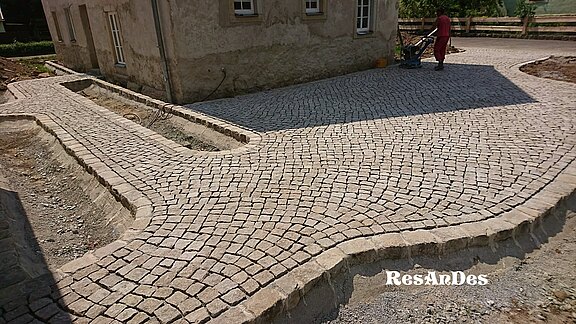
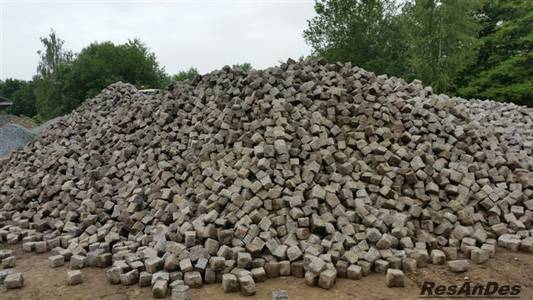
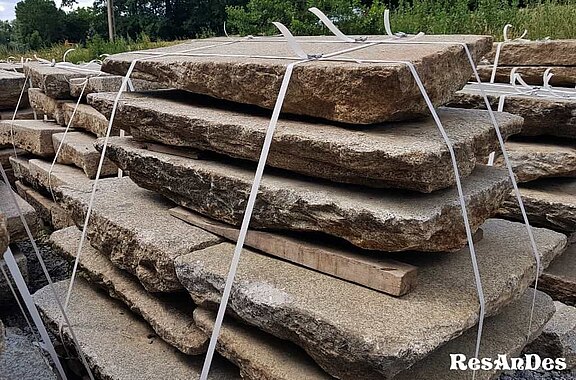
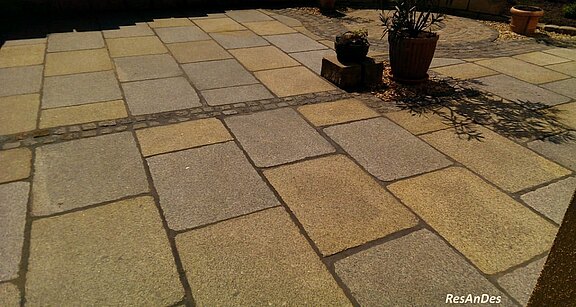
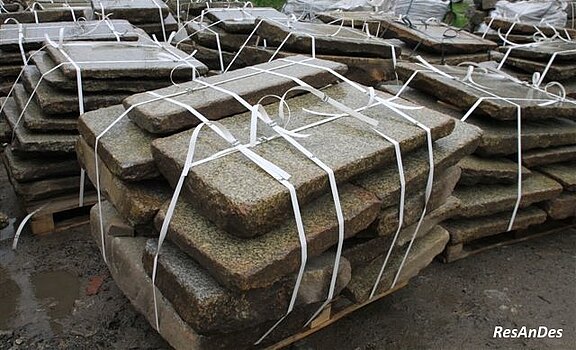

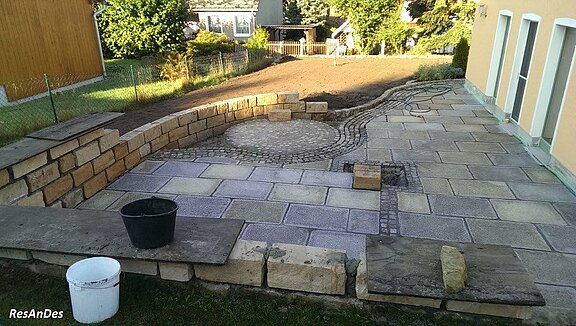
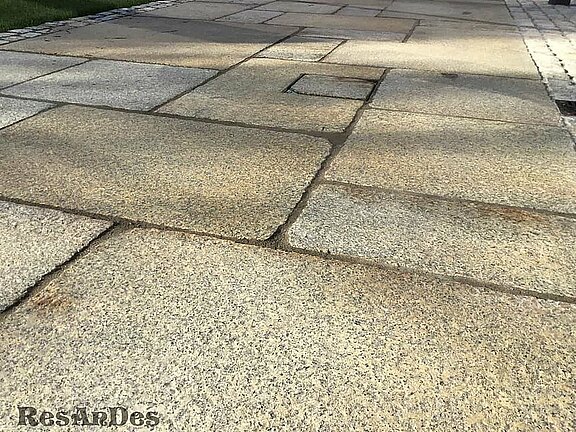
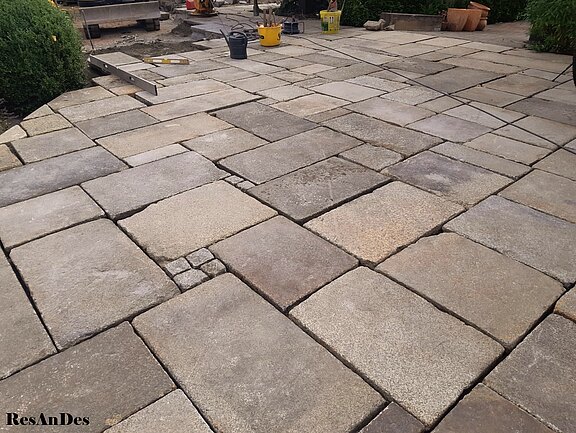
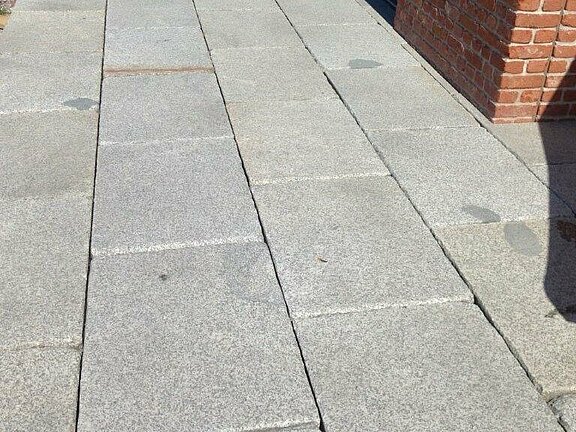
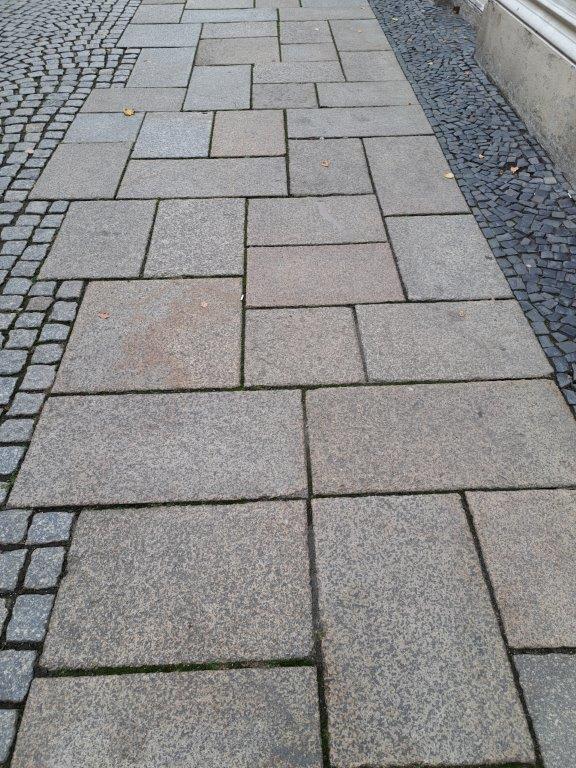
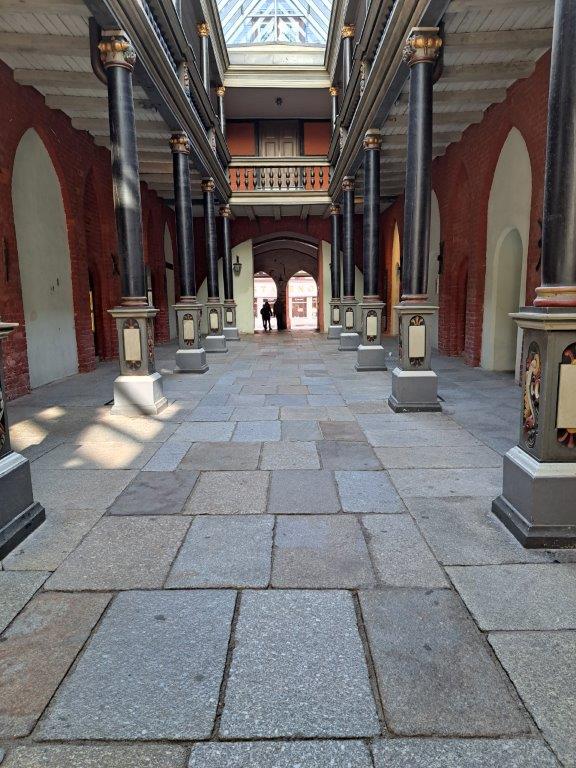
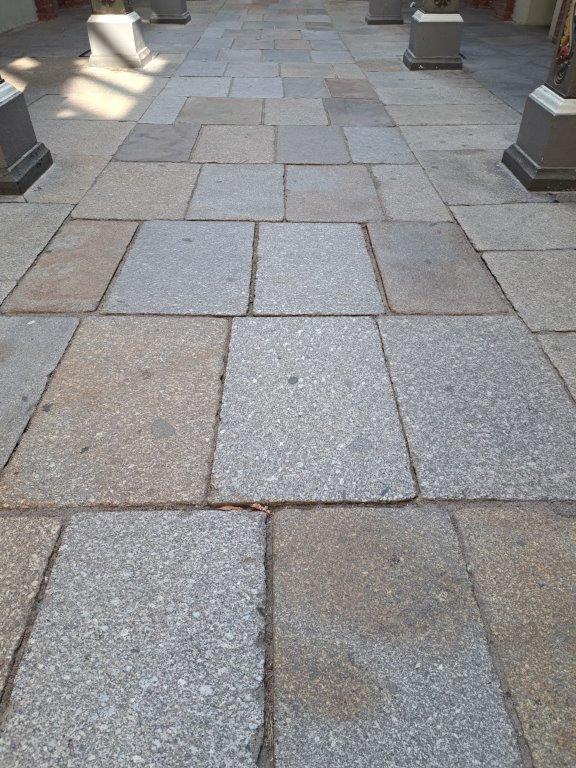
![[Translate to Englisch:] Alte Krustenplatten aus Oberlausitzer Granit](/fileadmin/_processed_/f/e/csm_krustenplatten_alte_granitplatten_resandes_antike-baumaterialien-sachsen_granitplatten-oberlausitz-lausitzer-granit_658ad828b8.jpg)
![[Translate to Englisch:] Granitplatten Anlieferung](/fileadmin/_processed_/1/b/csm_gredplatten-auflieger_67e2c38a7b.jpg)
![[Translate to Englisch:] historische Gradplatten](/fileadmin/_processed_/4/7/csm_historische-granitplatten_7ba1f8058d.jpg)